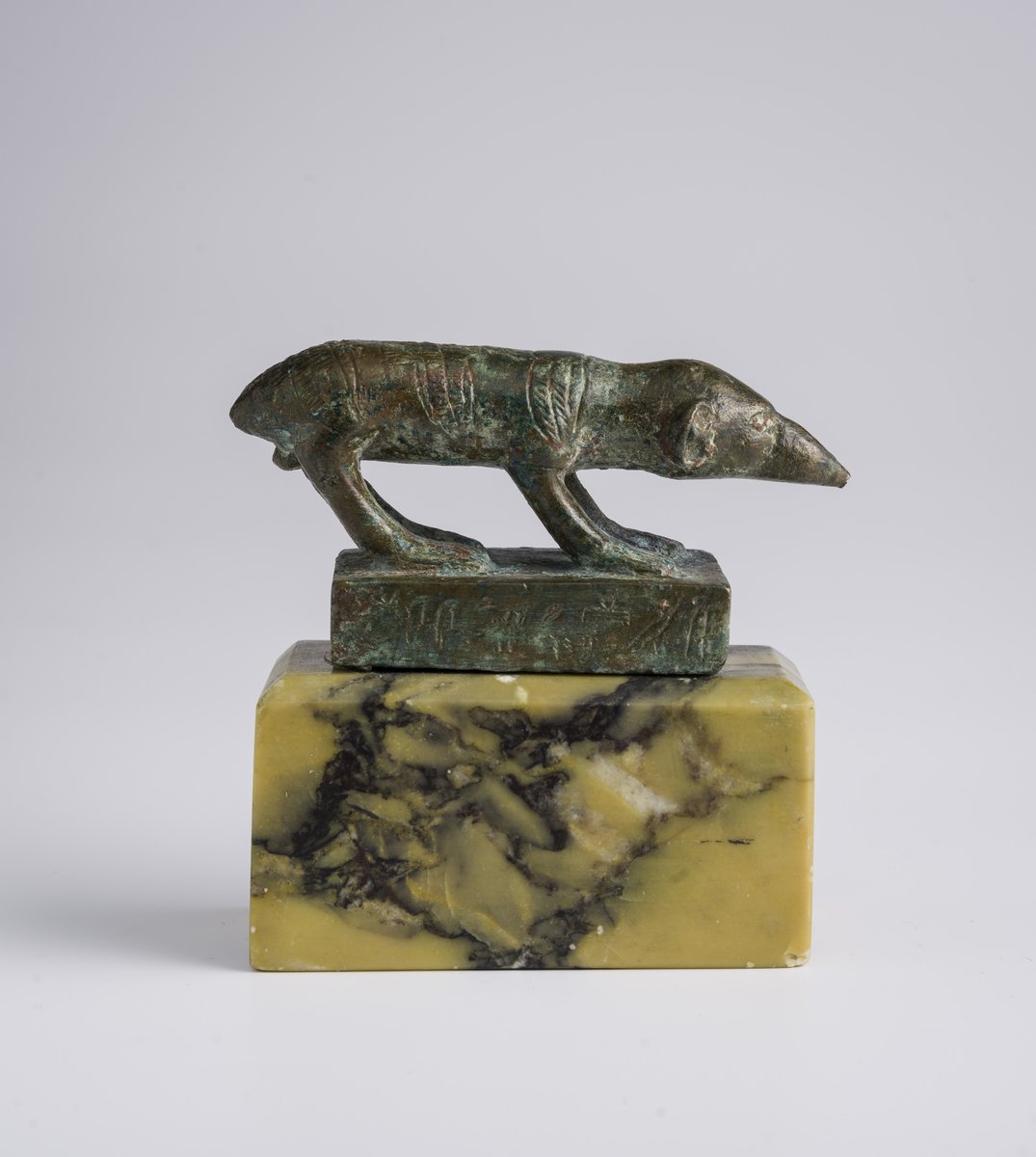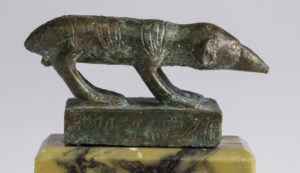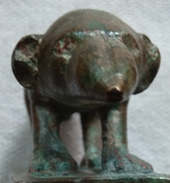
Shrewmouse surmounting relic box with hieroglyphic inscription
Egyptian Art
If you thought that being a shrew is boring, read the story of how this poor-sighted, untameable and belligerent nocturnal animal living underground graduated into being a deity guiding the Sun god’s bark in ancient Egyptian mythology.

The shrew
It is a coincidence that the darkly mysterious little figure of a shrew became the eponymous piece of the exhibition organised in the Kunsthistorisches Museum in Vienna in 2018 by film director Wes Anderson (Spitzmaus Mummy in a Coffin and Other Treasures) at the same time when a bronze statuette of a shrew entered the Egyptian collection of the Museum of Fine Arts in Budapest as a new acquisition from a Budapest private collection. Egyptologist and historian Péter Gaboda will explain the main features of this small creature below.
A shrew or a mongoose?
The nocturnal, underground lifestyle of the shrew proved so ‘successful’ in the long run that researchers did not realise for a long time that a deity in the form of a shrew had its own cult in ancient Egypt. Its bronze representations were mostly identified as those of the Egyptian mongoose (ichneumon). By now the characteristic traits that distinguish these two species are more or less known, as are the connections that so closely link them in Egyptian mythology.
 The carefully elaborated figure standing on a little bronze box (now forming part of the Egyptian collection of Museum of Fine Arts) can be clearly identified as that of a shrew based on many of its external features. The eyes of the short-sighted shrew are small and deep set. Its poor eyesight is partly compensated by its excellent senses of smell (observe its long, pointy nose) and hearing (its small, round, internally coupled ears visibly project away from the head).
The carefully elaborated figure standing on a little bronze box (now forming part of the Egyptian collection of Museum of Fine Arts) can be clearly identified as that of a shrew based on many of its external features. The eyes of the short-sighted shrew are small and deep set. Its poor eyesight is partly compensated by its excellent senses of smell (observe its long, pointy nose) and hearing (its small, round, internally coupled ears visibly project away from the head).
The legs of the statuette must have been affixed to the cylindrical body separately: they are in a standing position, next to one another and slightly slanting forward. In ancient Egyptian iconography this way of depicting legs symbolised inactivity and stillness. The tail- which was presumably long and thin – is broken off. Winged deities and other depictions linked to the Sun-god are engraved into the figure’s back, this being a general characteristic feature of bronze shrew statues and shows affinity with the decoration on bronze statues of Apis bulls.
A sacred animal
In this type of shrew statuette the remains of the actual animals were placed in the box under the figure, which functioned as a kind of relic holder. The animal’s body in the closed box was waiting to be revived and regenerated after death, while the figure atop was the cult image which the revived deity ‘moved into’ and was thus able to be embodied. The sacred animal selected for this purpose was never the symbol of a specific deity but one of its exactly defined aspects, which, according to Egyptians, best characterised him or her in a given situation. So what could this aspect have been?
A glutton
The shrew has a small frame coupled with a high metabolic rate; therefore, the animal had a reputation for being a complete glutton. It is an insectivore but it also eats seeds, snails and on occasion finds even mouse pups palatable. At the same time, the shrew itself is – supposedly – taken off the menu of predators as its peculiar odour of civet/musk ejected when in danger is not exactly to their liking. The shrew’s fragile body and timid nature are often accompanied by nervous reactions of self-defence. It was widely known by ancient Egyptians for its fierce, untameable and choleric nature.
“The one with no eyes in his face”
The person who erected the votive statuette in the Budapest collection as an offering saw the primary importance of the shrew in its underground (afterlife) and furtive, nocturnal lifestyle. The Egyptians regarded the shrew as completely blind due to its degenerated eyes (cf. the Latin expression mus caecus, meaning ’blind mouse’). It was exactly because of this blindness that shrews were associated with the blind and seeing god.
The being of the god was complex and had a dual nature. One of his aspects was called “the one whose eyes (the Sun and the Moon) are in his face” (Mechenti-irti in old Egyptian), and the other was “the one with no eyes in his face” (Mechenti-n-irti in old Egyptian). This god was revered in Letopolis as one of the aspects of Horus, who, as myth has it, was blind at birth. According to Egyptians, this Horus of Letopolis assists the Sun god during his nocturnal journey on the solar bark. The shrew embodies the blind, eyeless aspect of the god, while his seeing aspect is represented by a diurnal animal, the snake-and rat-killer mongoose (ichneumon).
A guide on the solar bark
Egyptians linked the shrew – an animal able to find its way in the dark – to the descending phase of the Sun’s nocturnal journey, which lasted until the sixth hour of the night. The shrew assumed the form of the god Horus to enter the afterlife and descended into the darkness of the afterlife to revive the deceased/Osiris. In this phase of the journey, he helped to navigate the solar bark through the dark, while his reforming power accelerated the regeneration of the deceased. The more combative functions in the ascending phase of the Sun god’s journey, after the sixth hour of the night, were given to the companion animal: the ichneumon (mongoose).
Continual transformation
Similarly to the shift from daytime to night-time, the transition between the two aspects of the same god, i.e. the shrew and the ichneumon was seen as a dynamic process of continual transformation/transubstantiation. This regular transformation there and back means an important change of state for the shrew: it is transformed from a blind into a seeing being and from a being of the afterlife/inactive being into a perfectly reborn being able to act dynamically in the light of daytime.
What does the inscription say?
The hieroglyphic inscription at the front and on the right side of the plinth is a request to the aspect of (temporarily blind) Horus of Letopolis, depicted as a shrew, to “grant life (in the afterlife)” for a certain Imhotep.